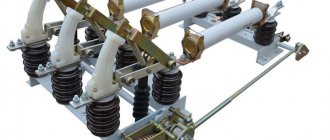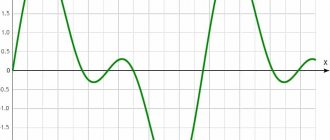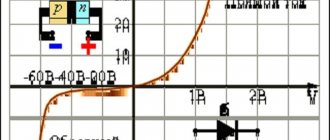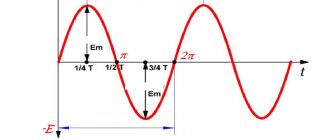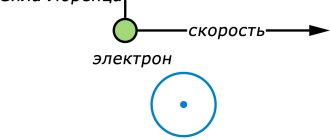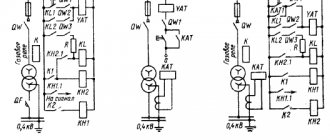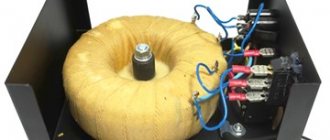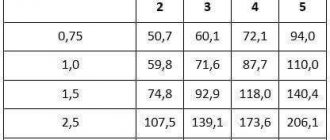Purpose of the AChR
AFR keeps the frequency characteristics in the system at a set level. If there is a drop in the power of the generated current at the power plant, using this system ensures that the most critical consumers are maintained in working order, the disconnection of which can create an emergency situation, therefore the automation disconnects unimportant connections, most often starting with category 3 consumers.
If measures are not taken in a timely manner, the entire power system may suffer as a result. For this purpose, the elements of AFR are used.
Separation of consumers by categories
Classification of categories:
- Consumers are divided into categories based on importance. Disabling equipment of the first category can pose a danger to human life.
- Problems with consumers of the second degree of importance can negatively affect the production cycle of industrial enterprises, causing serious material losses.
- The third category does not imply serious consequences in the event of a blackout and is accepted as a priority for shutdown in the event of an emergency.
Design and principle of operation
The figure below shows the AFR response circuits, which assume the use of frequency automatic reclosure:
Also read: Automatic transfer of reserve - ATS
If the frequency drops below the set value, the KF frequency relay is activated. Next, the signal is transmitted to the temporary relay KT1 with the contacts closing on the intermediate group relays KL1 and KL2. This is how the power supply to consumers is controlled according to the established priority.
The frequency characteristics of the system are then checked using a measuring element. As soon as the frequency reaches the standard value of 50 Hz, a start command is sent to the measuring module through temporary CT2. Next, using the intermediate KL4, the contacts are closed to reconnect the equipment.
Operating principle
Look at the figure, as you can see, here is an AFR circuit with frequency reclosure. If the frequency drops to the set level or below, the KF frequency relay is activated. From it, the signal is sent to the time relay KT1, which closes the groups of contacts of the intermediate relays KL 1 and 2. They are the ones who manage the disconnection of consumers in accordance with the established priority.
After this, the measuring element checks the frequency level in the network. When the frequency reaches 50 Hz, it triggers a signal from the measuring block circuit to temporary KT2. Then, through the intermediate KL4, the contacts are closed to connect consumers back to the network, which is how the FACR is carried out.
Classification
Power plants and substations are equipped with various AFR systems, which provide for the use of one of four protections or the simultaneous operation of several of them. The classification includes the following types of these elements:
- AFC1 (first) – shutdown is carried out within half a second, with the trigger settings in the event of a frequency drop of 1.5 to 3.5 Hz from the nominal one. The range value can be adjusted in 0.1 Hz steps. Consumers are switched off in stages, depending on power characteristics;
- AFR2 (second) – frequency parameters are similar, but the time interval increases from 5 to 90 seconds;
- ZAChR – designed for use in nuclear power plant conditions. The time interval is set to trigger within 0.5 seconds;
- CHAPV – with frequency automatic restart.
These elements can be used individually or in combination.
AFR devices
There are several current categories of AFR devices:
- AFCI is a type of device that has one time setting and several frequency settings. Serves to prevent the occurrence of a decrease in frequency after an emergency situation occurs. The time setting is 0.5 sec. The frequency setting ranges from 48.5 to 46.6 Hz. There are several ACPI queues, about 20 of them in total, the difference between the queues is Δf = 0.1 Hz. The load operating from the ACPI is distributed evenly between the queues. When a certain number of queues are processed, the frequency drop stops or “freezes” at 47 or 47.5 Hz.
- AChRII is a category that includes several time settings and one frequency setting. It is used to return the frequency to the required value, ensuring the operation of the power system in normal mode, after it “freezes”, in this category the frequency setting is 48.6 Hz, the time setting is set in the range of 5 - 69 seconds. AChRII queues differ in time settings by 3 seconds. When AChRII is triggered, the frequency value is set to 49 Hz.
- FFA - frequency automatic restart is used to restore power supply to electricity consumers who were disconnected during the operation of the AFR in accordance with a certain sequence, guided by the frequency values and according to the position of the time and frequency settings, as well as according to the responsibility of energy consumers.
CHAPV refers to special-purpose automation devices that provide an impulse to turn on consumers stopped during emergency mode.
The FACR is triggered at a frequency of 49.5 or 50 Hz, with an initial time setting of 10 - 20 seconds with an interval between bursts of at least 5 seconds. The sequence of activation of the emergency response is the reverse of the operation of the emergency response, in that the action of the last stage of the emergency response corresponds to the action of the first stage.
Together with AFR, ALAR and dividing protection are used to restore active power.
Fig No. 1. Diagram of an AFD device based on the frequency of the absolute value, used for industrial enterprises. Triggering consists of the action of a frequency relay and the activation of an intermediate relay that disconnects consumers
AFR schemes
According to established standards, AFRs may provide for the performance of various protective functions. The circuits involve the use of relay and semiconductor elements.
With one frequency relay
The diagram below shows an element with one frequency relay:
The command is sent from the measuring module through the intermediate relay RP to frequency RF1.
When the frequency parameters drop, RP1 and RP2 are closed, from the latter the signal is transmitted to turn off the power supply.
Also read: Under what conditions is parallel operation of transformers allowed?
If the frequency is restored to the standard value, the circuit returns to its original state. Through RP5, the command is sent to RP5.1, with the coils PB1 and RP4 turned off.
If the operation of the system according to the specified scheme turns out to be impossible, PB1 is shunted.
WITH CHAPV
Automatic frequency unloading assumes the following scheme:
The order of operation of relay protection is similar to the previous example. Through P4, the command is transmitted to the time relay PB1, with the excitation of the windings on the intermediate RP1.
Through RP1.1 and RP2.1 the system is turned off. Signaling about this is provided by RU1.
When the situation normalizes, current is supplied through RP1.3 and RP3.2 to winding PB2, with the relay of the intermediate group RP4 turned on. Next, with the help of RP4.2 and RP 4.3, consumers are started, with signaling from the indicator relay RU2.
Requirements for automatic frequency shedding
The amount of power applied to the AFR must be sufficient to eliminate the power shortage.
The AFR device should help avoid the occurrence of a “frequency avalanche”.
It is necessary to fully comply with the disconnected load to the value of the power deficit.
After the AFC is triggered, the frequency value must return to the previous standard frequency value or to a value of at least 49 Hz.
A short-term decrease in the frequency value should not lead to the operation of AFC devices.
In addition to automatic frequency unloading of categories I and II, additional unloading exists and is used; it serves to perform local unloading when the shortage of active capacities appears too high, when both AFC capacities of categories I and II are clearly insufficient to prevent the emerging shortage.
Requirements
To ensure normal operation, the AFR must meet the following requirements:
- successfully eliminate emergency situations of various types - triggering, regardless of the extent of the damage;
- perform a shutdown in accordance with the established settings for time and the magnitude of the characteristics deviation;
- de-energize the minimum number of consumers;
- provide for the possibility of stepwise shutdown;
- exclude spontaneous operation without appropriate grounds.
The listed conditions are intended to ensure normal operation of the equipment and its proper protection.
Consequences of reducing frequency
If the frequency in the network decreases by up to 0.4 Hz, this situation will not significantly affect the operation of the equipment. But if the frequency characteristics drop by 2 Hz or more, this can lead to irreversible processes, both in the power grid itself and in the operation of consumers.
Also read: Efficiency - transformer efficiency
If the response is insufficient, the situation can develop unpredictably, even leading to serious accidents. As a result, the operating mode of the equipment is disrupted, with the risk of overheating of the machines and damage to the insulation, leading to their failure.
The use of AFC allows you to automatically turn off the system in case of significant frequency deviations from the nominal value, preventing the creation of an emergency situation.
Emergency frequency unloading of power systems - AFR with a large number of queues
Page 9 of 14
With the creation of unified power systems in Russia, frequency unloading with a large number of queues began to be used. In addition, an additional automation queue was modified, which is designed to raise the frequency close to the nominal for the subsequent resynchronization of the separated area. Automatic unloading consists of two parts (categories). The first category AFR-I is designed to stop the frequency reduction and has frequency settings of 48.5 - 46.5 Hz. A large number of queues are assigned in this frequency range. The approximate number of queues can be up to 15-20. In this case, between adjacent queues Δ f = 0.l Hz, and due to the error of the frequency relay, non-selective operation of the queues is possible. Queues spaced from each other by Δ f=(0.2 - 0.3) Hz or more operate selectively among themselves. Low-responsible consumers are added to queues with settings close to the upper limit (48.5 Hz). Critical consumers are switched off during large frequency drops. The total power of consumers connected to AFR-I is assigned according to the maximum possible generation deficit, taken with some margin. The calculated power value can be taken as the power of the largest generator, an entire station, or a power shortage caused by a disconnection of the communication line with the power grid. As a first approximation, you can focus on 25-30% of the power of the allocated area (energy system). The assigned unloading power is distributed equally between the AChR-I queues. So, for example, with 20 queues and the total power of AChR-1 at 30% Rnom, consumers with a power of 1.5% Rnom are added to each queue. Thus, using this method, the energy system is unloaded in small portions of 1.5% or less. To eliminate false operation of the frequency relay in transient mode, a short time delay of 0.1-0.2 s is assigned. The second category AFR-ll with a single frequency setting of 48.5 Hz for all queues of this category and different time settings is intended to “pull” the frequency after the action of AFR-I to the level of 49.5-50.0 Hz. The minimum time setting AChR-ll is selected equal to 10 s. Thus, AChR-ll begins to operate after all the turns of AChR-1 have practically already worked. The power of consumers connected to AChR-11 is approximately assigned according to the condition Δfс=0.4Δf|. The number of AChR-2 queues is also chosen to be large (for example, 10) with a time delay between adjacent queues of Δ t=(2-3)c. Thus, AChR-2 also unloads in small portions, ensuring an increase in frequency due to further disconnection of consumers. After the action of AChR-2, the frequency will be raised at least to the level of 48.3 Hz. At this frequency value, the automation will stop operating. In Fig. Figure 16 shows the process of frequency reduction with a generation deficit in the ΔΡ system (curve 4) and frequency stabilization due to the action of the AFC. To plot the frequency reduction graph under the action of AFR-I, characteristic 2 is adopted, corresponding to the number of queues n=oo. In this case, the construction of the transient process is extremely simplified - starting from the f1 setting, the frequency decreases according to an exponential law with a steady deviation value and time constant (curve 5). Before the start of AChR-2 action, a time delay of 10 s is set. From this moment the frequency begins to increase. Figure 16 shows two limiting options for raising the frequency by the action of AFC-ll. The first option assumes the absence of any delay in the AChR-ll channel. In this case, when the first stage of the AChR-ll is triggered, the frequency at the same moment will rise by a certain value f. After 3 seconds, the next queue takes effect and the process continues. As soon as the frequency reaches 48.5 Hz, the process of raising the frequency will stop, since subsequent AFR-ll queues will not work. The nature of the transition process is marked by step graph 6. The second option assumes a delay in the AChR-2 channel, significantly greater than the time delay Δ t between adjacent AChR-2 queues. Since the frequency rise is delayed, now all stages of the AChR-2 will work, and the frequency can rise above 48.5 Hz by an indefinite value (step characteristic 7). So, for example, when and when all stages of AChR-2 are triggered, the system frequency will be raised by 3 Hz (kn = 2). If after activation of AChR-1 the frequency is established at 47.0 Hz, then AChR-2 will increase the frequency to the nominal 50 Hz. If the rise starts from a level of 48.0 Hz, then the action of AChR-2 will lead to an increase in frequency to 51 Hz. Thus, despite the action of AChR-2 in small portions and, it would seem, the possibility of raising the frequency to a given level, here uncertainty arises regarding the steady-state value of the frequency after the operation of the automation. Let us make a general assessment of frequency unloading for the considered option. An increase in the number of AChR-I queues has a positive effect on the process of unloading the energy system. Here, unloading is carried out in small portions, which helps to disconnect consumers by the amount necessary to stop the frequency reduction. In this case, the frequency is set within the range of 46.5-48.5 Hz. Frequency unloading AChR-I and AChR-ll are successfully operated in Russian power systems. However, this automation is far from perfect. And first of all, this concerns the methodological side of the problem. Research shows that frequency, power and time settings are chosen intuitively. There are no substantiated recommendations on the purpose of these settings, calculation of transient processes, etc. In this regard, studies of frequency unloading with a limiting transition to an infinitely large number of AFC-I stages make it possible to configure the automation to the optimal option with a minimum frequency deviation in emergency conditions and a minimum duration of the transition process.
- Back
- Forward
